A) polyphyletic taxa
B) paraphyletic taxa
C) monophyletic taxa
D) polyphyletic taxa and paraphyletic taxa
F) B) and C)
Correct Answer

verified
Correct Answer
verified
Multiple Choice
Based on cladistics, which eukaryotic kingdom is polyphyletic and, therefore, unacceptable?
A) Plantae
B) Fungi
C) Animalia
D) Protista
F) A) and B)
Correct Answer

verified
Correct Answer
verified
Multiple Choice
The reason that paralogous genes can diverge from each other within the same gene pool, whereas orthologous genes diverge only after gene pools are isolated from each other, is that ________.
A) having multiple copies of genes is essential for the occurrence of sympatric speciation in the wild
B) paralogous genes can occur only in diploid species, thus they are absent from most prokaryotes
C) polyploidy is a necessary precondition for the occurrence of sympatric speciation in the wild
D) having an extra copy of a gene permits modifications to the copy without loss of the original gene product
F) B) and C)
Correct Answer

verified
Correct Answer
verified
Multiple Choice
Use the following information to answer the question. Paulinella chromatophora is one of the few cercozoans that is autotrophic, carrying out aerobic photosynthesis with its two elongated "chromatophores." The chromatophores are contained within vesicles of the host cell, and each is derived from a cyanobacterium, though not the same type of cyanobacterium that gave rise to the chloroplasts of algae and plants. A crucial photosynthetic gene of the cyanobacterium that gave rise to the chromatophore is called psaE. This gene is present in the nuclear genome of the cercozoan, but is not in the genome of the chromatophore. This is evidence of ________.
A) reciprocal mutations in the chromatophore and nuclear genomes
B) horizontal gene transfer from bacterium to eukaryotes
C) genetic recombination involving a protist and an archaean
D) transduction by a phage that infects both prokaryotes and eukaryotes
F) B) and C)
Correct Answer

verified
Correct Answer
verified
Multiple Choice
A large proportion of archaeans are extremophiles, so called because they inhabit extreme environments with high acidity, salinity, and/or temperature. Such environments are thought to have been much more common on primitive Earth. Thus, modern extremophiles survive only in places that their ancestors became adapted to long ago. Which of the following is, consequently, a valid statement about modern extremophiles, assuming that their habitats have remained relatively unchanged?
A) Among themselves, they should share relatively few ancestral traits, especially those that enabled ancestral forms to adapt to extreme conditions.
B) On a phylogenetic tree whose branch lengths are proportional to the amount of genetic change, the branches of the extremophiles should be shorter than the non-extremophilic archaeans.
C) They should contain genes that originated in eukaryotes that are the hosts for numerous species of bacteria.
D) They should currently be undergoing a high level of horizontal gene transfer with non-extremophilic archaeans.
F) B) and D)
Correct Answer

verified
Correct Answer
verified
Multiple Choice
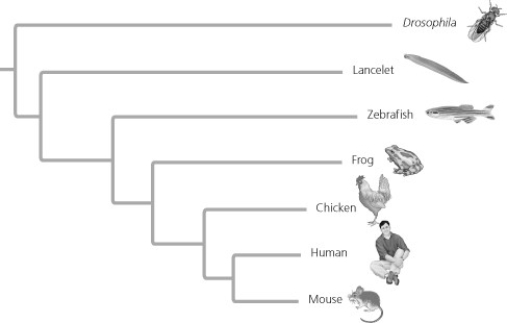 The relative lengths of the frog and mouse branches in the phylogenetic tree in Figure 26.13 indicate that
The relative lengths of the frog and mouse branches in the phylogenetic tree in Figure 26.13 indicate that
A) frogs evolved before mice.
B) mice evolved before frogs.
C) the homolog has evolved more rapidly in mice.
D) the homolog has evolved more slowly in mice.
F) None of the above
Correct Answer

verified
Correct Answer
verified
Multiple Choice
In a comparison of birds and mammals, the condition of having four limbs is
A) a shared ancestral character.
B) a shared derived character.
C) a character useful for distinguishing birds from mammals.
D) an example of analogy rather than homology.
F) C) and D)
Correct Answer

verified
Correct Answer
verified
Multiple Choice
Which of the following statements is accurate, at least according to our present knowledge?
A) Eukaryotes acquired nuclear genes only in the distant past; these genes can allow survival in anaerobic environments.
B) Genes from prokaryotes have been acquired by some eukaryotes; these genes can allow survival in extreme environments.
C) Prokaryotes acquired genes from eukaryotes many times; these genes can allow survival in extreme environments.
D) Prokaryotes acquired genes from fungi; these genes can allow the digestion of cellulose.
F) A) and C)
Correct Answer

verified
Correct Answer
verified
Multiple Choice
The question refers to the following table, which compares the percent sequence homology of four different parts (two introns and two exons) of a gene that is found in five different eukaryotic species. Each part is numbered to indicate its distance from the promoter (for example, Intron I is the one closest to the promoter) . The data reported for species A were obtained by comparing DNA from one member of species A to another member of species A.
% Sequence Homology
 Which of these four gene parts should allow the construction of the most accurate phylogenetic tree, assuming that this is the only part of the gene that has acted as a reliable molecular clock?
Which of these four gene parts should allow the construction of the most accurate phylogenetic tree, assuming that this is the only part of the gene that has acted as a reliable molecular clock?
A) Intron I
B) Exon I
C) Intron VI
D) Exon V
F) None of the above
Correct Answer

verified
Correct Answer
verified
Multiple Choice
Three living species X, Y, and Z share a common ancestor T, as do extinct species U and V. A grouping that consists of species T, X, Y, and Z (but not U or V) makes up
A) a monophyletic taxon.
B) an ingroup, with species U as the outgroup.
C) a paraphyletic group.
D) a polyphyletic group.
F) B) and C)
Correct Answer

verified
Correct Answer
verified
Multiple Choice
The lakes of northern Minnesota are home to many similar species of damselflies of the genus Enallagma. These species have apparently undergone speciation from ancestral stock since the last glacial retreat about 10 thousand years ago. Sequencing which of the following would probably be most useful in sorting out evolutionary relationships among these closely related species?
A) conserved regions of nuclear DNA
B) mitochondrial DNA
C) amino acids in proteins
D) ribosomal RNA
F) C) and D)
Correct Answer

verified
B
Correct Answer
verified
Multiple Choice
There is some evidence that reptiles called cynodonts may have had whisker-like hairs around their mouths. If true, then hair is a shared ________.
A) derived character of mammals, even if cynodonts continue to be classified as reptiles
B) derived character of all vertebrates and not of the mammal clade
C) ancestral character of the all vertebrates, but only if cynodonts are reclassified as mammals
D) derived character of mammals, but only if cynodonts are reclassified as mammals
F) C) and D)
Correct Answer

verified
D
Correct Answer
verified
Multiple Choice
The following question refers to this phylogenetic tree, depicting the origins of life and the three domains. Horizontal lines indicate instances of gene or genome transfer.
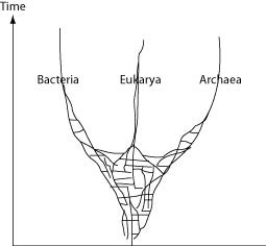 A possible phylogenetic tree for the three domains of life.
If the early history of life on Earth is accurately depicted by the figure, then which statement is most in agreement with the hypothesis proposed by this tree?
A possible phylogenetic tree for the three domains of life.
If the early history of life on Earth is accurately depicted by the figure, then which statement is most in agreement with the hypothesis proposed by this tree?
A) The last universal common ancestor of all extant species is one individual species.
B) The origin of the three domains appears as a polytomy.
C) Archaean genomes should not contain genes that originated in bacteria, and vice versa.
D) Eukaryotes are more closely related to archaeans than to bacteria.
F) A) and C)
Correct Answer

verified
Correct Answer
verified
Multiple Choice
Imagine that a phylogeny was developed for a group of mammals based on bone structure. Which of the following statements would be a reasonable prediction about a phylogeny for the same group of species based on similarities and differences in the structure of a particular enzyme?
A) The same phylogeny would be unlikely.
B) The same phylogeny would be predicted.
C) No prediction could be made.
D) The amino acid sequence would be identical in all species.
F) None of the above
Correct Answer

verified
Correct Answer
verified
Multiple Choice
Based on the tree below, which statement is not correct?

A) Goats and humans form a sister group.
B) Salamanders are a sister group to the group containing lizards, goats, and humans.
C) Salamanders are as closely related to goats as to humans.
D) Lizards are more closely related to salamanders than to humans.
F) A) and B)
Correct Answer

verified
Correct Answer
verified
Multiple Choice
The following question refers to the following phylogenetic trees.
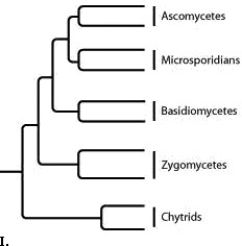
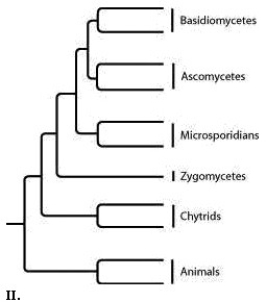
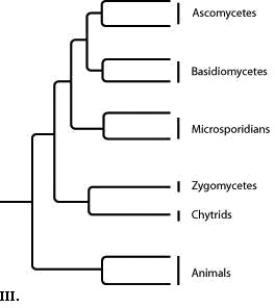
 Which tree shows the greatest evolutionary distance between chytrids and ascomycetes?
Which tree shows the greatest evolutionary distance between chytrids and ascomycetes?
A) I
B) II
C) III
D) IV
F) C) and D)
Correct Answer

verified
Correct Answer
verified
Multiple Choice
Use the following information to answer the question.
Giardia intestinalis can cause disease in several different mammalian species, including humans. Giardia organisms (G. intestinalis) that infect humans are similar morphologically to those that infect other mammals, thus they have been considered a single species. However, G. intestinalis has been divided into different subgroups based on their host and a few other characteristics.
In 1999, a DNA sequence comparison study tested the hypothesis that these subgroups actually constitute different species. The following phylogenetic tree was constructed from the sequence comparison of rRNA from several subgroups of G. intestinalis and a few other morphologically distinct species of Giardia. The researchers concluded that the subgroups of Giardia are sufficiently different from one another genetically that they could be considered different species. (T. Monis, et al. 1999. Molecular systematics of the parasitic protozoan Giardia intestinalis. Mol. Biol. Evol. 16[9]:1135-44.)
![Use the following information to answer the question. Giardia intestinalis can cause disease in several different mammalian species, including humans. Giardia organisms (G. intestinalis) that infect humans are similar morphologically to those that infect other mammals, thus they have been considered a single species. However, G. intestinalis has been divided into different subgroups based on their host and a few other characteristics. In 1999, a DNA sequence comparison study tested the hypothesis that these subgroups actually constitute different species. The following phylogenetic tree was constructed from the sequence comparison of rRNA from several subgroups of G. intestinalis and a few other morphologically distinct species of Giardia. The researchers concluded that the subgroups of Giardia are sufficiently different from one another genetically that they could be considered different species. (T. Monis, et al. 1999. Molecular systematics of the parasitic protozoan Giardia intestinalis. Mol. Biol. Evol. 16[9]:1135-44.) According to the phylogenetic tree in the figure above, G. intestinalis constitutes a ________ group. A) analytic B) monophyletic C) polyphyletic D) paraphyletic](https://d2lvgg3v3hfg70.cloudfront.net/TB1096/11ea298c_b7ef_fd22_b59c_490f034e2755_TB1096_00_TB1096_00.jpg) According to the phylogenetic tree in the figure above, G. intestinalis constitutes a ________ group.
According to the phylogenetic tree in the figure above, G. intestinalis constitutes a ________ group.
A) analytic
B) monophyletic
C) polyphyletic
D) paraphyletic
F) C) and D)
Correct Answer

verified
Correct Answer
verified
Multiple Choice
A phylogenetic tree constructed using sequence differences in mitochondrial DNA would be most valid for discerning the evolutionary relatedness of ________.
A) archaeans and bacteria
B) fungi and animals
C) chimpanzees and humans
D) sharks and dolphins
F) B) and C)
Correct Answer

verified
Correct Answer
verified
Multiple Choice
Use the following information to answer the question.
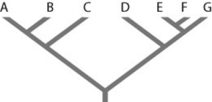 Refer to the figure. Which of the following forms a monophyletic group?
Refer to the figure. Which of the following forms a monophyletic group?
A) A, B, C, D
B) C and D
C) D, E, and F
D) E, F, and G
F) B) and C)
Correct Answer

verified
D
Correct Answer
verified
Multiple Choice
Use the following information to answer the question.
 Which of the following trees, if any, depicts the same relationship among species as shown above?
Which of the following trees, if any, depicts the same relationship among species as shown above?
A) ![]()
B) ![]()
C) ![]()
E) A) and B)
Correct Answer

verified
Correct Answer
verified
Showing 1 - 20 of 75
Related Exams